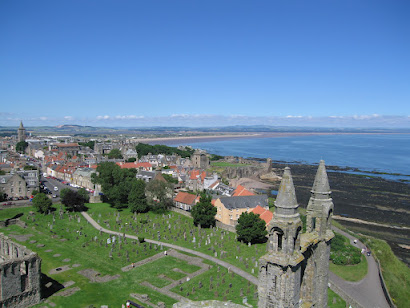How can a small town of only 18,000 people perched on a bay of the North Sea hold so much history, mystery, and glamour? Because it is in the country of Scotland and it is the town of St. Andrews.
St. Andrews was named for the patron saint of Scotland, Andrew. Amazingly, the town was the foundation for much of Scotland: it was the center of the church of Scotland; it is the home of Scotland's oldest University; and it is entitled the "Home of Golf"...which is also another form of religion in Scotland. St. Andrews is a tiny, precious gem of a town that has been preserved from development so that it still retains much mystery and her physical history remains a part of 21st century life.
St. Andrews Castle was built in 1200 and remained a place of significant battles for over 350 years. Today the remnants of the castle are still perched on a cliff over the North Sea bay where one can walk through and visit. For the daring, the secret tunnels and mine shafts are available for tour; however, one must not be claustrophobic as they are deep underground and dark. There is a Vistitor's Centre on site, but it is more of a gift shop, so I encourage you to head straight for the castle grounds where sitting on a bench in the former castle courtyard it is not hard to imagine life 600 years ago.
Nearby the magnificent St. Andrews Cathedral looms over the entire town and can be seen from miles away at sea. One can go to the top of the Cathedral and take in a bird's eye view of this exquisite town, or one can walk through the ruins looking at the many architectural remnants and gravestones that still occupy the lush grounds. The Visitor's Centre at the Cathedral is definitely worth a trip as it is interesting, educational, and moving.
For most people in the 21st century, however, St. Andrews represents two things: the Home of Golf on the Old Course, and the University where William and Kate met. Neither will disappoint.
Golf was first played in Scotland in 1400 where the wild links style of golf unfolded on the bunkers adjacent to the sea. James II subsequently banned golf in 1451, but by the reign of James IV the whole country was mad for golf, including James, so by 1502 the game was back on and it has continued to be the country pastime. Today, five courses comprise the Links along with two club houses and a driving range, and all are open for play to the public. I was there in 2005 when the British Open was being played on the Old Course, and it was a memorable moment for even non-golfers as the winds swept across the sea and legends of golf wrestled with the wild terrain and wicked winds.
The University of St. Andrews was founded in 1413, and is the oldest university in Scotland. Classes are held in centuries old buildings and life unfolds on the cobblestone streets of the town. It is so rich in history; so devoted to the great Scottish writers of the 19th century; so small and preserved. In other words, it is a rare and privileged university experience.
After a tour of the castle, cathedral, and university; after a blistering round on the links, St. Andrews has many luxury accommodations. However, I have a favorite secret: Rusacks Hotel on the 18th green of the Old Course. It is in a 19th century building that faces the 18th green and the sea beyond, and almost every room has a view. The rooms are large and most comfortable with every amenity. The food and service are outstanding. However, it is the experience of sitting in the bar with a raging fire and a cold drink watching the wind whip the grasses bordering the beach and the green and listening to the Scots discuss the round of the day that make this a magical place.
St. Andrews is a world unto itself and one that is whole in itself: whether religion, education, recreation, or luxury relaxation, this town has it all.
Tuesday, June 3, 2008

St. Andrews from the Cathedral























